Scab on a pear: description and methods of treatment
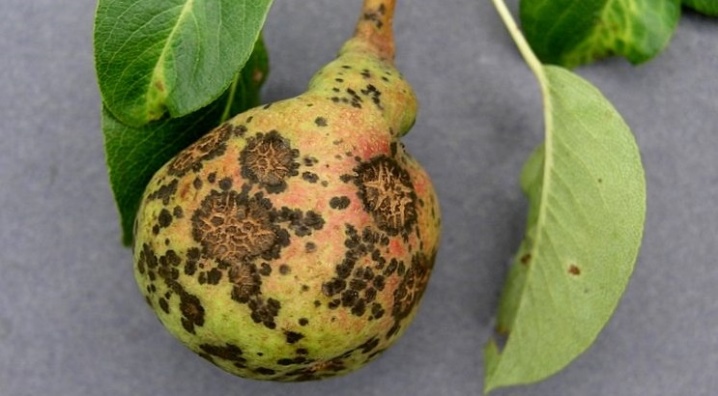
A scab on a pear is able to destroy an entire garden in a short time or significantly reduce the number of usable fruits. Fortunately, timely measures will help protect trees from disease.

Description of the disease
The scab on the pear is the result of the activity of pathogenic fungi and bacteria, or rather, of the spore actinomycete, which arises in the fallen leaves that have not been harvested before the winter season or on the shoots. With the arrival of spring and the melting of the snow covers, the bacteria are activated, the capsule bursts, and the spores are spread throughout the entire area under the influence of the wind. The higher the air humidity, the faster the scab develops, and the more plants become its prey. Not only pears can suffer from this disease, but also neighboring crops, especially if they are rarely looked after. Apple trees, however, do not get sick with pear scab, just as a pear cannot suffer from apple scab.
It happens that specimens that have weakened during the winter months or have given a bountiful harvest in the previous season are subject to disease. It takes 1-8 weeks from infection to complete destruction of the tree. Such a pear suffers from a loss in the quantity and quality of the crop, since fruits affected by scab spots are not allowed to be eaten. It should be added that if you remove for storage a pear with a small number of specks, they will gradually "creep" over the entire peel. The lack of timely measures leads to the loss of the fruit trees themselves, since after a long illness they either stop yielding or completely die. It also happens that the fruits do not appear for 2-3 years.


The first manifestations of scab can be seen already at the beginning of spring. Yellowish spots appear on the leaves, which eventually swell and burst. The tree itself looks pale, dull olive, as if it has lost its bright colors. Inflorescences, ovaries and shoots are gradually covered with brown spots. Flowers often fall off even before the ovaries form.
The bark cracks and flakes. In summer, fruits are actively affected, which are drawn in by a network of cracks and change shape. If you compare such a fruit with a healthy pear, you will find that it has a smaller size, tough pulp and lack of sweet taste and smell. A weakened tree also suffers from impaired water exchange.
The presence of a grayish bloom with black spots suggests that it is prohibited to eat the fruit.
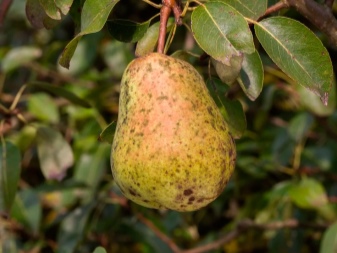
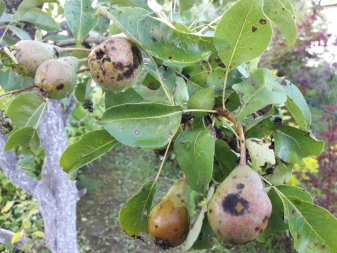
Reasons for the appearance
One of the reasons for the occurrence of pear scab is the increased humidity of the air and soil. As mentioned above, most often the disease occurs due to the presence of rotten foliage near fruit trees. The disease spreads faster if the planting is too thickened, the neighborhood of single-species pears. Scab can occur if a weakly immune variety is planted in an area that is characterized by sharp temperature fluctuations.
The disease should be expected after prolonged rains, accompanied by temperatures from 20 to 25 degrees, insufficient feeding or poor care. The first to get sick are already sick plants with reduced immunity.
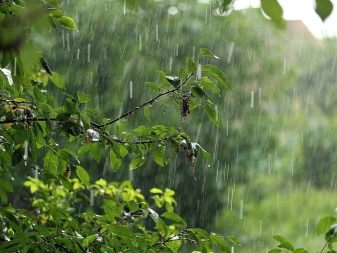

What can be processed?
You can fight scab on a pear in both folk and modern ways.
Traditional methods
Treatment with folk methods is considered effective only when the disease is at its initial stage. This technique is suitable for those who are afraid of the effects of chemicals on fruits, but are ready to wait several months until the disease is defeated. For example, after flowering, the culture can be sprayed with a solution of dry mustard, for the preparation of which a standard sachet of powder is diluted in 10 liters of warm water. It is important to carry out processing at a time when the fruits are still at the stage of formation, acquiring color and taste. Some gardeners apply mustard sprays four times a season.
Spraying with a solution of sodium chloride is considered quite effective. For its preparation, a kilogram of the substance is diluted in 10 liters of warm water. This procedure is carried out either before flowering, or after the pears are harvested from the trees. The salt used dries out the moisture and therefore makes the conditions unsuitable for the scab to spread. This treatment should be carried out in early spring before the buds open. In principle, a medium concentration potassium permanganate solution gives a good result, for the preparation of which 10 liters of warm water are also required.
The resulting liquid will need to be watered after sunset, and also used for spraying.
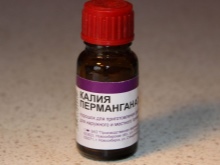

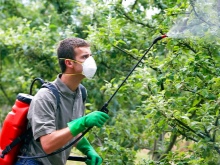
Experienced gardeners also use a decoction of horsetail. To create it, the greens are poured with freshly boiled water and infused for about 2 days. The solution is poured into the root zone even before the start of the spring season. Using folk remedies, it is important to disinfect not only the tree itself, but also the root circle with a radius of 2-3 meters. In order for the composition to be better fixed on the sheet plates during spraying, it can be supplemented with soap shavings of household or tar bar and even wood glue. It should not be overlooked that folk remedies act more slowly, which means that more treatments will be required than in the case of chemicals.
You will have to use homemade solutions immediately after preparation, otherwise they will lose all their useful properties. After stirring the mixture well, it will need to be filtered and poured into a fine spray bottle.
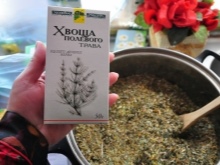
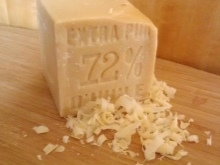

Chemicals
It is possible to get rid of scab on a pear with the help of chemicals only in the most serious cases. It is important to remember that such treatment is aggressive, and therefore leaves traces on fruit trees and reduces their immunity. Experts recommend alternately using different types of fungicides in order to understand which drug is most effective in a particular situation. The proven remedies for the disease include Bordeaux mixture, Fitosporin-M Reanimator, Skor, Topsin-M and Horus. Between their applications, you will have to maintain a pause of 5 to 10 days.
Some funds cannot be used during the flowering of the culture, which, however, is indicated in the instructions. As a rule, in order to completely eliminate the focus of the disease, trees have to be sprayed 3-4 times. Topsin M is especially effective at the initial stage of scab. Horus, being a broad-acting drug, is also used in spring for prophylaxis.
The last "chemical" spraying can be done about 3-4 weeks before the pears are harvested.
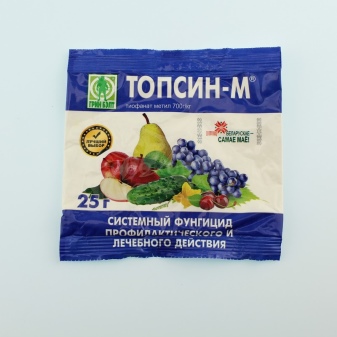
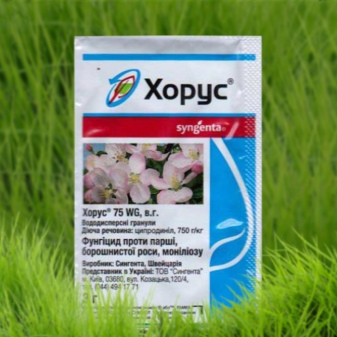
Treating pears with fungicides should be carried out on schedule, but taking into account the weather conditions and the severity of tree damage. In the most serious cases, sprays are arranged in the spring, when the buds swell, then when the buds form. In June-July, a two-stage treatment will be required: when the flowering ends and 2 weeks after this moment. The last treatment is carried out either at the end of August or at the beginning of September. If the summer is rainy, then the frequency of using fungicides should be increased up to 6-7 times. However, in order not to harm the pear, chemical preparations should alternate with folk recipes.If it starts raining after spraying, the treatment is immediately repeated as soon as a sunny day comes.
Before starting work, you will have to remove the most damaged or dried parts of the pear. It is better to start with gentle methods, and then move on to aggressive ones. Another important rule is not to use chemicals and salts on hot days.
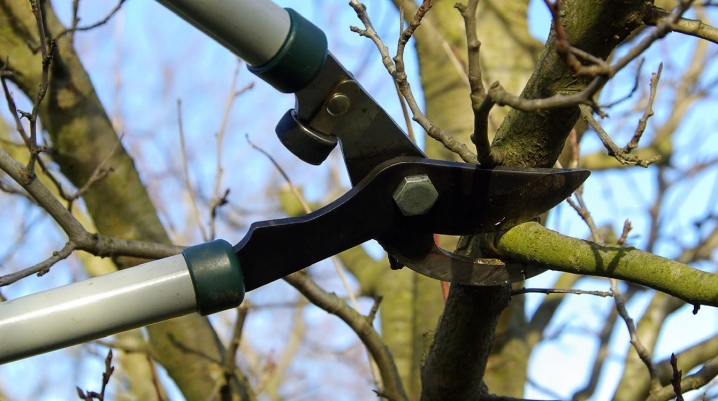
Disease Resistant Varieties
Some varieties of pears have an innate resistance to scab, so they are recommended to choose either for novice gardeners or those whose gardens are located in a humid climate. For example, "August dew" suitable for breeding in the central and southern parts of Russia. This variety has a strong immune system that protects against other diseases, as well as a sweet taste. "Dukhmyanaya" pear has medium scab resistance. Its greenish fruits are formed on low trees.
Variety "The sorceress" recommended for cultivation in the south of the country. It is unpretentious and famous for its quick fruit appearance. "Chizhovskaya" the pear is not only not afraid of scab, but also gives a bountiful harvest. The average height of such a tree reaches 2.5 m. Advantages "Tikhonovka" include strong immunity and high yields. Not afraid of this disease and pear "Severyanka"forming spotty yellow fruits with juicy pulp.
In addition to the above, you can also think about breeding the varieties "Etude", "Vyzhnitsa", "Marble", "Autumn Susova" and others.
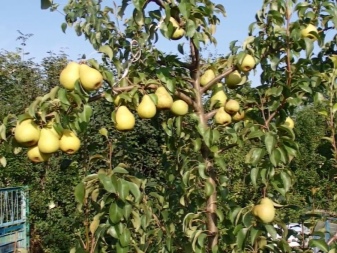
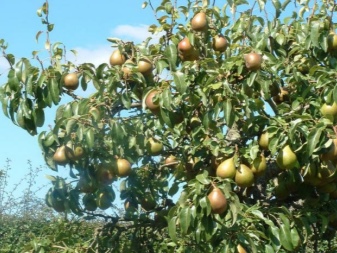
Preventive measures
The necessary protection of the pear can be ensured even by choosing the right place for planting. The crop should be placed in a well-lit area so that a gap of 2.5 m remains between single-species varieties. The closer the plants are planted, the more likely they are to become infected from each other. The place should be protected from winds, and the groundwater should be at a depth of 2 meters. Not only in the pear "corner", but throughout the garden, it will be correct to avoid thickening and the possibility of forming an overly humid environment.
It is important to check the mature tree regularly for damage, at least at the beginning of the season, before hibernation and throughout the growing season. Cutting off damaged or dry branches, the "wound" should always be disinfected with manganese solution, and also covered with garden varnish. The trunk circle must always be kept clean, it must be cleaned of fallen leaves and weeds. In spring and autumn, sanitary pruning should also be organized, removing damaged and weakened shoots. To normalize the water exchange of the culture, it makes sense to use mineral complexes or to spray with ammonium nitrate or potassium salt. This treatment should be carried out at the end of the winter months.


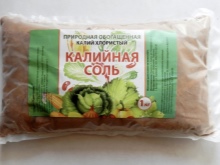
We must not forget that preventive measures are useless if the tree is initially infected, therefore, when buying seedlings in a nursery or growing it yourself, it is important to carefully check them. In the autumn, after completing the harvest, you will need to collect all the fallen leaves, and then burn it. At the next stage, the earth in the near-trunk circles is dug up with a shovel deepening by 30 centimeters. A heavily thickened crown is necessarily thinned out, regardless of the season, and suspicious fruits and leaves are immediately removed.
After falling leaves or harvesting, it is also recommended to feed the pears with a mineral complex. It must contain potassium carbonate, phosphorus and silicon. When the tree has shed all the foliage, it makes sense to also saturate the ground with 7 percent urea or 10 percent ammonium nitrate. By the way, when drawing up a planting plan for the next year, it is worth placing plums, apricots or peaches next to the pear - that is, those crops that do not suffer from scab.
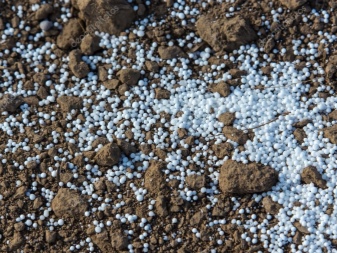
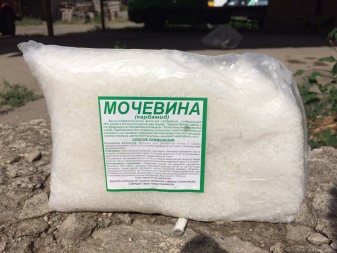













The comment was sent successfully.